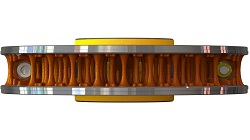Quieter, safer and greener freight transport
Europe’s railway industry is continuously modernising its infrastructure and equipment, as railway operators adopt cutting-edge technologies and innovations. On these lines, the EU-funded FUTURA(opens in new window) project has developed new braking systems that minimise noise and are more efficient. “Freight trains run more frequently at night and are ten times noisier than modern passenger trains,” says Ivan Smolej, project coordinator. “We developed a new generation of brake discs for freight wagons that reduce the noise considerably, offer shorter braking distance, enable higher speeds, facilitate maintenance and promote safety,” he adds. Better brakes in every respect The new divided rail freight brake (DRFB) discs can reduce noise by up to 10 decibels and raise speeds for freight trains of up to 160 km/h. “The discs are lighter, which allows more tonnage to transport goods,” explains Smolej. The project team developed and tested five different prototypes of brake discs, meeting or exceeding initial project objectives. The research involved interviews with customers and market analyses, examining as well issues such as CO2 reduction, energy consumption, megacities, aging populations, and of course noise reduction. “We narrowed down the prototypes to two: one with brake plate width of 170 mm and the other with 110 mm, both of which passed demanding dynamometer bench tests and live tests,” reveals Smolej. The 170 mm plate achieved 22.7 % less mass, 21 % less air resistance, and 17.3 % more thermal dissipation efficiency compared to traditional discs. The 110 mm plate, which research showed was very much in demand, achieved even better results: 34.5 % less mass, 34 % less air resistance and 32.7 % thermal dissipation efficiency. Both models can handle a maximum velocity of 160 km/h. Noteworthy as well, the braking distance of a freight train will decrease by 11 %, which will in the long term ensure 7 % less accidents according to the project, while vibration will decrease by 14 %. Better heat dissipation will improve the reliability of braking system operations as the brakes will not overheat and are much less likely to break down. Commercialisation in full swing Today’s new freight wagons are mostly equipped with less efficient and cheaper K-block brakes. The project’s DRFB disc brakes represent the current state-of-the-art braking system for freight trains, where the brake crown is a single piece. “This will enable much wider use of brake disks as they will be marketed at a better price than K-block brakes,” says Smolej. When DRFB hits the market, the consortium will be the only provider of this type of disc worldwide. “Commercialisation of DRFB discs, which boast a much lower life-cycle cost than the K-Block brakes, will make K-Block brakes obsolete,” he highlights. Over the next five years, the project consortium hopes to equip 45 % of all new freight wagons with DRFB discs. “This will result in other benefits such as shorter braking distance, safer rail freight transport, lower noise and vibration levels, and better financial results for rail transport providers and users,” asserts Smolej. Already, the consortium has received considerable interest from the European market, especially Austria, France, Germany and Switzerland, where the noise level of freight trains must be reduced to between 8-10 dB by 2025. In Germany and Switzerland, 80 % of all freight wagons will be classified as “silent or non-noise making” by 2025, representing 180 000 wagons in total. Health and environment emerge as winners Noise from freight trains affects the health of millions who live or work near train tracks and DRFB discs are expected to improve the quality and safety of life of over 55 million EU citizens. “The social cost of rail traffic noise in the EU is at least 2.4 billion euros per year, representing a sizeable budget that can be used for healing different diseases caused by high noise levels, from anxiety and sleep disturbances to cardiovascular diseases,” says Smolej. Lastly, railways represent the most environmentally-friendly mode of transport both for freight and passenger traffic. DRFB discs are going to play a crucial role in furthering this noble mode of transport.







